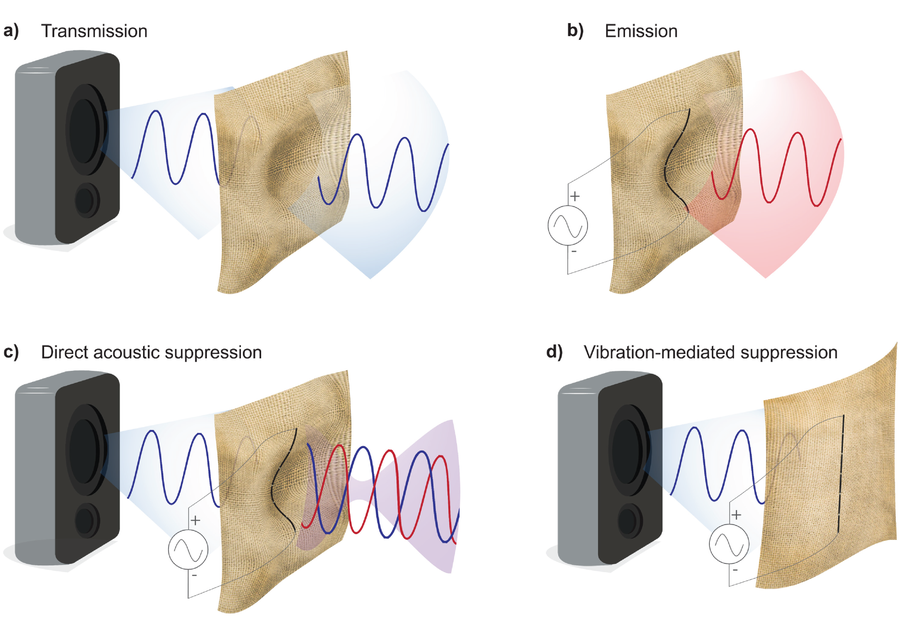A Vibrating Curtain of Silk Can Stifle Noise Pollution
Inspired by headphone technology, silk sewn with a vibrating fiber acts as a lightweight sound barrier

Andriy Onufriyenko/Getty Images
Harsh and unwanted sounds are almost everywhere. The World Health Organization has said that noise pollution bombards hundreds of millions of people globally, contributing to stress, sleep problems and even cardiovascular disease. And anyone who has woken up to a clanking jackhammer or rumbling garbage truck knows that home isn’t always much of an escape. Noise pollution passes into buildings and between rooms when sound waves—mechanical pulses of pressure—hit surfaces such as walls and windows and cause them to vibrate. These vibrations then create even more sound waves in the interior of the structure. Although foam insulation and other suppressing materials can counteract some of this by dampening vibrations in walls, they are often bulky and unsightly.
A noise-blocking sheet of silkworm silk that is far slimmer and more portable could greatly streamline the pursuit of silence. “Quiet is a rare commodity these days,” says Yoel Fink, a materials scientist at the Massachusetts Institute of Technology, who recently published a study describing the silk prototype in Advanced Materials.
The silk sheet, which is enhanced with a special fiber, expands on a technology also found in noise-canceling headphones. These devices create silence by sampling the ambient noise and then emitting sound waves that are out of phase with those in the environment. When the ambient and emitted waves overlap, they cancel each other out. Because this works best when the waves overlap perfectly, it’s easier to achieve in a small space (such as the one within headphones’ ear cups). Silencing an entire room is a much bigger challenge, but the researchers wanted to try applying basic noise cancellation principles to a more elegant, less obtrusive form of insulation.
On supporting science journalism
If you’re enjoying this article, consider supporting our award-winning journalism by subscribing. By purchasing a subscription you are helping to ensure the future of impactful stories about the discoveries and ideas shaping our world today.
Fink and his colleagues stitched a single piezoelectric fiber—which can convert vibrations into electricity, and vice versa—into a sheet of silk. The scientists’ past research had proved that the piezoelectric fabric could translate acoustic sounds into electricity—effectively turning the silk sheet into a microphone. To get the sheet to produce noise-canceling vibrations, they just needed to reverse the process.
The researchers hung an about three-inch-wide circle of piezoelectric silk fabric in the lab and applied a voltage from a wall outlet to the piezoelectric fiber. The electrified fiber began to vibrate the whole silk circle, causing it to emit sound. The researchers could tune the voltage to play music through the silk (they chose “Air,” by Johann Sebastian Bach). Having successfully shown they could finely control the fabric’s vibrations, they next aimed to use their silk speaker to blot out undesired sounds.

A vibrating silk fabric can emit sounds such as music (b). It can also suppress noise by emitting out-of-phase frequencies (c) or by inducing interfering mechanical waves in the material (d).
The team played a single-frequency tone from a speaker placed on one side of the silk and, on the other, measured the tone’s volume by microphone. When they played the same frequency through the silk speaker—out of phase with the original source—they found they could suppress sounds as loud as 65 decibels, roughly the volume of a normal human conversation. “That was striking to me because it’s a piece of silk [with] the thickness of a hair,” Fink says.
Such a setup smothers the most noise at the location where the waves directly interfere. To block the sounds of a typical human conversation, the silk would need to be about 40 inches away from its participants. The authors suggest that hanging these specialized silk sheets in multiple places around a room could help achieve greater levels of silence.
The team also experimented with a different sound-blocking method that produced even better results. Just like sound-carrying vibrations in air, solid materials vibrate as mechanical waves. And two overlapping mechanical waves that are out of phase can interfere with each other; in a physical medium, that interference creates a motionless surface. The researchers suspected they could take advantage of this property to physically suppress noise in a room. In this case, they wouldn’t have the silk emit a single noise-canceling note. Instead they created mechanical waves in the silk itself, with these waves opposing those of a sound played in the room. When the conflicting vibrations met in the silk, they canceled each other out, and the fabric became still. The approach is “like a mirror for sound,” Fink says, in that it effectively reflects sound waves. Using this technique, the sheet prevented 75 percent of the sound from passing through.
“This is an interesting result,” says Sara Nabil, a computer scientist and designer at Queen’s University in Ontario, who wasn’t involved with this study. “A next step is to pass it on to people to see how they might use it in their daily lives.” Nabil says she could envision the sound-blocking silk being especially useful in a hospital environment—which is often noisy and where rest is crucial.
Fink’s next step will be to test how well the silk suppresses more complex everyday noises that have many frequencies—what he calls “the richness of the sounds we have around us.” After that, he’s confident his team can scale up production of the silk so it can be available to the public, likely in the form of hanging drapes that will be weighted at the bottom for added tension. Fing has a personal incentive to do so: creating a distraction-free workplace for himself and his colleagues. “We want to get away from all the noise and have the quiet to really focus on science,” he says.
Until then, Fink has been thinking of the silk wherever he encounters loud sounds—including a recent Taylor Swift concert. As dazzling as her performance was, “the noise levels were insane,” he says. The volume and the elaborate fabrics in Swift’s outfits kept bringing him back to the noise-canceling silk.
